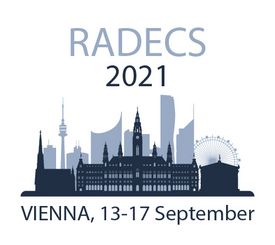H-1: Radiation Field Study in ATLAS: Timepix measurements vs Geant4 simulations
T. Billoud1, B. Bergmann1, C. Leroy2, S. Menke3, S. Pospíšil1
1 Institute of Experimental and Applied Physics, Czech Republic
2 Université de Montréal, Canada
3 Max Planck Institute for Physics, Germany
New methods to characterize radiation in the ATLAS experiment have been developed using Timepix detectors. Measurements of total ionizing dose and charged particle fluences at different locations in the experiment are used to benchmark Geant4 simulations.
H-2: A Framework for Global Trapped Particle Radiation Modelling
C. Papadimitriou1, I. Sandberg1, S. Aminalragia-Giamini1, H. Evans2, P. Jiggens2
1 SPARC, Greece
2 ESA, Netherlands
We present a unified framework, to consolidate both data and methodologies, perform comparisons under the same constraints, and produce trapped particle radiation models that can be tailored to any future user's use-case scenarios.
H-3: lnfer electron space environment along EOR mission profile from LEO measurements: application to EUTELSAT 7C
D. Lazaro1, A. Sicard1, P. Caron1, D. Falguère1, R. Ecoffet2, D. Standarovski2, N. Balcon2, J. Mekki2, V. Thakur3, P. Timmerman3, R. Hernandez3, G. Schneider3, C. Keys4, M. Baylocq4
1 ONERA, France
2 CNES, France
3 EUTELSAT, France
4 MAXAR, USA
Using correlation between LEO and equatorial electron measurements, a methodology is presented and validated, with the ICARE-NG detector measurements on board EUTELSAT 7C to infer flux encountered by the spacecraft during its EOR phase.
H-4: ln-flight Measurements of Radiation Environment Observed by Eutelsat 7C (Electric Orbit Raising Satellite)
P. Caron1, S. Bourdarie1, D. Falguère1, D. Lazaro1, P. Bourdoux2, V. Thakur4, P. Timmerman4, R. Hernandez4, G. Schneider4, C. Keys5, M. Baylocq5, N. Balcon3, D.Standarovski3, J. Mekki3, R. Ecoffet3
1 ONERA, France
2 EREMS, France
3 CNES, France
4 EUTELSAT, France
5 MAXAR, USA
Measurements of particle fluxes (protons and electrons) obtained with the ICARE-NG monitor on the Eutelsat 7C orbit (Electric Orbit Raising to geostationary orbit) are presented.
H-5: Development of a Miniaturized Reference Dosimeter Payload for SmallSat Applications
C. Tscherne1, M. Wind1, L. Huber1, M. Latocha1, I. Slipukhin2, S. Uznanski2, R. Garcia Alía2, A. Hörmer3, R. Zeif3, O. Koudelka3, H. Fragner4, A. Dielacher4, C. Pirat5, F. Perez-Lissi5, G. Santin5, P. Beck1
1 Seibersdorf Laboratories, Austria
2 CERN, Switzerland
3 Graz University of Technology, Institute of Communication Networks and Satellite Communications, Austria
4 RUAG Space GmbH, Austria
5 ESA, Netherlands
We present the TID Reference Dosimeter and SEU Assessment System, a miniaturized dosimetry payload for SmallSats. We provide information on the concept, performance, development, and preparations for its in-orbit demonstration onboard the Austrian CubeSat PRETTY.
H-6: First results from ESA Next Generation Radiation Monitor units on-board GEO EDRS-C and LEO Sentinel-6
I. Sandberg1, S. Aminalragia-Giamini2, C. Papadimitriou2, R. van Gijlswijk3, D. Heynderickx4, W. Hajdas5, M. Heil6, H. Evans7
1 Space Applications and Research Consultancy, Greece
2 Space Applications and Research Consultancy (SPARC), Greece
3 Solenix-DE, Germany
4 DH Consultancy, Belgium
5 PSI, Switzerland
6 ESA ESOC, Germany
7 ESA ESTEC, Netherlands
First results from ESA Next Generation Monitor on-board EDRS-C are presented. Special attention is given on the measurements of the unit during the GTO of the satellite. Evaluation and comparisons with other monitors are reported.
PH-1: Design of a Space Radiation Monitor for a Sounding Rocket and Results from the First Turkish Sounding Rocket Flight
A. Albarodi1, M. B. Demirköz1, U. Kılıç1, A. B. Can1, E. Karadöller1, D. Boztemur1, M. Aktaş2, T. C. Atasever2
1 Middle East Technical University, Turkey
2 ROKETSAN, Turkey
A radiation monitor was produced and flown to an altitude of 136 km twice on top the SR0.1 rocket launched with measurement of the Pfotzer-Regener maximum and the effects of the CME on October 28th, 2020.
PH-2: Upper envelop in GREEN model for energetic electrons
A. Sicard1, V. Maget1, D. Lazaro1, N. Balcon2, R. Ecoffet2
1 ONERA, France
2 CNES, France
The aim of this study is to develop a GREEN "Upper Envelop" model for electrons which takes into account the variation from one solar cycle to another.
PH-3: lnvestigation of Inner Belt Flux Anisotropies
F. Enengl1, H. Evans2, R. Horne3
1 University of Oslo, Norway
2 ESA ESTEC, Netherlands
3 British Antarctic Survey, United Kingdom
We investigate pitch angle distributions in the inner radiation belt in equatorial regions. We use data from IREM (INTEGRAL mission) and PROTEL (CRRESmission). We find a dependency of flux anisotropies on the proton energy levels.
PH-4: Association of relativistic electron enhancements with VLF/ULF wave activity and seed electrons
A. Nasi1, I. A. Daglis1, C. Katsavrias1, W. Li2
1 National and Kapodistrian University of Athens, Greece
2 Boston University, USA
This study addresses the association of solar wind conditions, geomagnetic parameters, wave activity, and seed electrons, and indicates that seed electron presence, plasmasphere erosion and wave activity are conditions leading to substantial relativistic electron enhancements.
PH-5: Flight data analysis of highly miniaturized TID monitor module onboard TRISAT
L. Gonzales1, G. Kirbiš1, D. Selčan2, I. Kramberger1
1 University of Maribor, Slovenia
2 SkyLabs d.o.o., Slovenia
This paper presents design, temperature and irradiation calibration, and in-flight data of PIN diode base TID monitor module, appropriate for use on nanosatellites missions. The module is highly miniaturized and uses COTS components.
PH-6: Space Environment & Effects Satellite (SE&ES) Mission Concept Feasibility Study
P. Jiggens1, J. Vennekens1, P. Lux1, N. Lawton1, S. Clucas1, C. Poivey1, D. Steenari1, H. Evans1, M. Millinger1, V. Braun1, S. Mutch1, M. Khan2, M. Verhoef1, G. Salinas1, C. Terhes1, B. Sousa2, K. Benamar1, Y. Le Deuff1, M. van Pelt1, M. Magazzu1, T. Wablat1, D. Lomanto1, P. Nieminen1, S. Rason1, V. Ferlet-Cavrois1
1 ESA ESTEC, Netherlands
2 ESA ESOC, Germany
Initial conclusions of a feasibility study for a low-cost, short-duration mission to measure the space environment whilst simultaneously measuring effects on components, testing mitigation strategies and giving flight heritage to new detectors and components.
PH-7: Development of a plastic scintillator-based active shield for the ICARE-NG radiation monitor
M. Pinson1, P. Caron1, P. Laurent2, I. Cojocari2
1 ONERA, France
2 CEA, France
An active shield using a scintillator and silicon photo-multipliers (SiPMs) has been developed to operate with the ICARE-NG instrument to reduce electron contamination through the sides of the detector, thus increasing energy resolution.
PH-8: Analysis of the photoneutron field near the THz dump of the CLEAR accelerator at CERN with SEU measurements and simulations
G. Lerner1, A. Coronetti1, J. Kempf2, R. Garcia Alía1, F. Cerutti1, A. Gilardi1,3, W. Farabolini´1,4, R. Corsini1
1 CERN, Switzerland
2 ISAE-Supaero, France
3 University of Naples Federico II, INFN Naples, Italy
4 CEA-Saclay, France
We study the photoneutron field near the THz dump of the CLEAR electron accelerator at CERN using FLUKA simulations and SEU measurements with SRAM memories, characterising its properties and evaluating its suitability for radiation tests.














